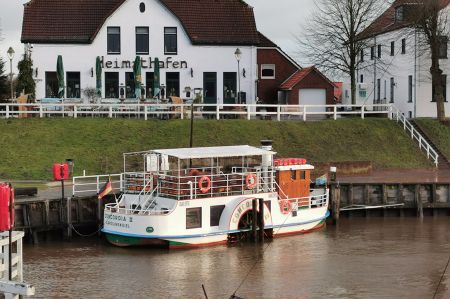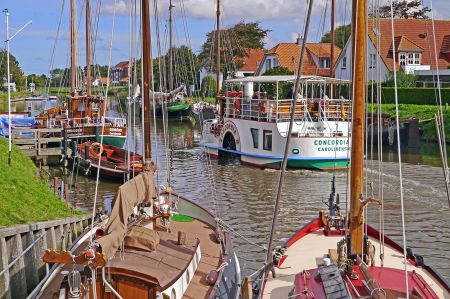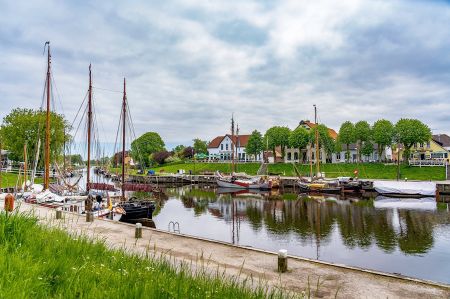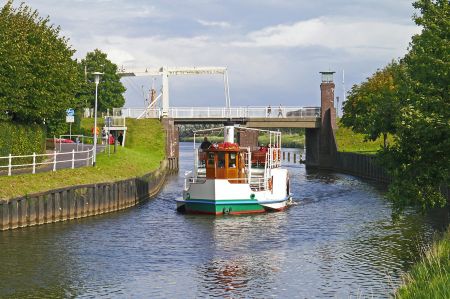Paddle steamer trip with the Concordia II in Carolinensiel
- Written by Portal Editor
Enjoy a ride on the Harle along the promenade from Carolinensiel to Harlesiel, spring is fast approaching, something like this could be the advertising slogan for the holiday resorts of Carolinensiel – Harlesiel.
A few days ago we had the opportunity to take a walk along the Harle and also visit the museum harbour with the numerous flat-bottomed ships. Despite the storm and the still winter cold, an experience that brought us closer to the history of Harlebucht with its storm surges and the land reclamation that followed through dykes.
 From a very early date, the Harle was of great importance for freight traffic and as a waterway to the coastal ports that were then located on Harle Bay. Through a branch of the Harle, it was possible to sail to today's market square in Wittmund, which is hardly imaginable today. It was similar in Jever, where the battle is intended to commemorate the former port location, which was accessible via the Hookstief. So it was obvious to use these waterways for passenger transport as well. In order to do justice to this, in 1853 the mayor of Carolinensieler, P.J. Fimmen and the grain dealer W. Feßner founded the corporation "Carolinensieler-Wittmunder-Dampfschifffahrts-Gesellschaft". The 80 shares, each worth 30 reichsthalers of gold, were sold quickly and passenger traffic could begin on the Harle, as there were hardly any paved roads.
From a very early date, the Harle was of great importance for freight traffic and as a waterway to the coastal ports that were then located on Harle Bay. Through a branch of the Harle, it was possible to sail to today's market square in Wittmund, which is hardly imaginable today. It was similar in Jever, where the battle is intended to commemorate the former port location, which was accessible via the Hookstief. So it was obvious to use these waterways for passenger transport as well. In order to do justice to this, in 1853 the mayor of Carolinensieler, P.J. Fimmen and the grain dealer W. Feßner founded the corporation "Carolinensieler-Wittmunder-Dampfschifffahrts-Gesellschaft". The 80 shares, each worth 30 reichsthalers of gold, were sold quickly and passenger traffic could begin on the Harle, as there were hardly any paved roads.
The paddle steamer Concordia begins its service
 A short time later, the Wittmund office and the Esen hydraulic engineering inspection sent the recommending report to the Aurich Landdrostei:
A short time later, the Wittmund office and the Esen hydraulic engineering inspection sent the recommending report to the Aurich Landdrostei:
“Everyone is interested in it, of course one is pretty much certain that the shares will not be profitable, but the circumstance worries at most one or the other shareholder who had to subscribe to a few shares on an honorary basis. The public is of the opinion that the steamship will in any case be for their amusement and convenience and that at most the shareholders can be harmed by it, which is out of the question, however, because they all have to lose 5 or 10 Pistols will easily get over".
Despite the bad expectations, the paddle steamer Concordia (= Eintracht) was built by the Elsner brothers' shipyard in Koblenz in 1854 and reached Carolinensiel on September 23, 1854. With a length of 13.32 m and a width of 2.20 m, she could transport 30 passengers, the captain, the engineer and a sailor with a full load of coal.
The Concordia I begins its passenger journeys
 In order to pass the low bridges at Alt- and Neufunnixsiel, a passenger deck was dispensed with and cabin superstructures were arranged in the fore and aft ship. A trip to Wittmund, 15 km away, was possible at 6 km/h and took about 2.5 hours.
In order to pass the low bridges at Alt- and Neufunnixsiel, a passenger deck was dispensed with and cabin superstructures were arranged in the fore and aft ship. A trip to Wittmund, 15 km away, was possible at 6 km/h and took about 2.5 hours.
However, the use of the Concordia I did not last long. As early as 1856 their inefficiency was determined. Too few used the iron paddle steamer and shipping traffic had to be completely stopped when it was freezing. In addition, a country road was built between Wittmund and Carolinensiel, which was preferred by the passengers.
The Concordia lay unused in Wittmund harbour for a good year until it was finally sold in 1858/1859. To this day, however, it is not known who bought the paddle steamer.
Reederei Albrecht builds the Concordia II
 Our paddle steamer is the largest in East Friesland and probably the smallest in the world. Inge and Dieter Albrecht built the Concordia II on their own in their family business, the Albrecht shipping company, based on the model of the Concordia I. Despite the short era of the predecessor, some documents survived, which Albrechts based their new calculations and construction plans on. Albrechts and her staff built everything themselves, right down to the red paddle wheels with a diameter of three meters.
Our paddle steamer is the largest in East Friesland and probably the smallest in the world. Inge and Dieter Albrecht built the Concordia II on their own in their family business, the Albrecht shipping company, based on the model of the Concordia I. Despite the short era of the predecessor, some documents survived, which Albrechts based their new calculations and construction plans on. Albrechts and her staff built everything themselves, right down to the red paddle wheels with a diameter of three meters.
After seven months it was ready: the new paddle steamer Concordia II. The side paddle steamer is equipped with a diesel engine, a main engine with constant revolutions and a hydraulic system with two engines, which allows the Concordia II to rotate its paddle wheels in opposite directions.
 It would do a maximum of 12 km/h at 60 revolutions per minute. However, the 75 kilowatts of the machine are not fully utilized. Of course, the paddle wheels could also manage to move the paddle steamer on their own. In April 2000, a long-cherished dream finally came true: the newly built paddle steamer Concordia II was launched for the first time. There is room for 100 passengers in the plush saloon and on the upper deck of the paddle steamer, which is now used exclusively as a barge. At the end of the 2000 season, the Harle was already carrying 55,000 passengers.
It would do a maximum of 12 km/h at 60 revolutions per minute. However, the 75 kilowatts of the machine are not fully utilized. Of course, the paddle wheels could also manage to move the paddle steamer on their own. In April 2000, a long-cherished dream finally came true: the newly built paddle steamer Concordia II was launched for the first time. There is room for 100 passengers in the plush saloon and on the upper deck of the paddle steamer, which is now used exclusively as a barge. At the end of the 2000 season, the Harle was already carrying 55,000 passengers.
Please also read:
